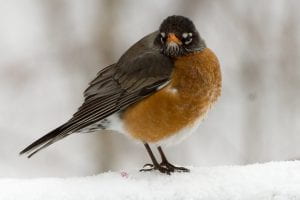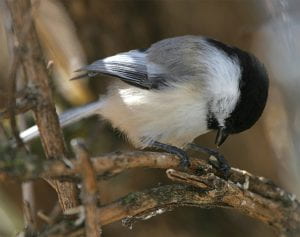When the weather gets rough, animals have to struggle to stay warm and find food without the benefit of a warm building, North Face gear and pizza delivery. What’s a critter to do?!
Braving the Cold

Fur and body fat are good insulators, and so are feathers (have you ever had a down jacket? Toasty!). As long as they stay dry, fluffed feathers can trap air that can be warmed by body heat and keep the little fellas from freezing. Some animals will also use shelters – tree cavities, evergreens, wood piles, your attic – anywhere they can tuck in to stay warm and dry.
Squirrels will use leafy nests, called dreys, they make high in the trees. Several squirrels may get cozy in one, while they cross their toes and hope the wind doesn’t blow the nest out of the tree!
Other animals, like opossums and raccoons, will hole up for several days wherever they can, including another animal’s den or burrow (hopefully, the resident has abandoned it or is a sound sleeper!). Opossums have to be extra careful – their hairless ears, toes and tails are prone to frostbite.
Stoking the Furnace

Warm-blooded or homeothermic animals, like mammals and birds, need to eat regularly to maintain their body temperature. While our friends the squirrels, along with opossums, raccoons and rats, can go dumpster diving, things are a bit more challenging for birds.
Birds with stout, triangular beaks, like sparrows, cardinals and finches, can forage for seed – remnants that are still on plants and any that people are generous enough to supply. Chickadees and blue jays will also eat seed. It’s fun to watch tiny chickadees hammer at seeds with their tiny beaks!
Woodpeckers drill holes into wood – mostly dead or dying trees, and the side of your house or garage – to eat the insects that are overwintering there. Chickadees look for insects hiding in plant stems. Some ducks and geese will stick around if there are still open bodies of water to forage in. Predatory birds, like our peregrine falcons, can continue to hunt prey (keep your eyes open for birds parts at the front of Old Main!)
And some robins do stay for the winter! They’ll eat persistent fruit, like crabapples and hawthorn berries, that are still clinging to the trees. That’s why we still see a few around campus. They can’t eat your food or any seed you might offer them, but they like blueberries!
The Take-Away
If these critters can make it, so can we! Just make sure you keep your skin covered and dry, eat enough nutritious food, seek shelter when needed, stay active, and make the most of those rare sunny days!
